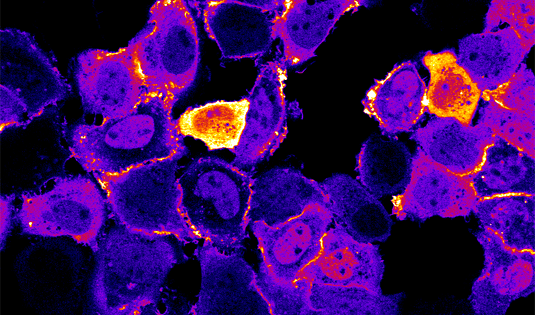Researchers create photosensitive mimics of a class of signaling molecules

Teams at LMU and EMBL have created photosensitive mimics of a class of signaling molecules, thus enabling their actions to be regulated by light, and affording new insights into the communications networks that control cellular metabolism.
Cells react to external stimuli by means of receptors on the plasma membrane, which in turn convey signals – generally referred to as second messengers – into the cytoplasm. Among the most important of these second messengers are the so-called diacylglycerides (DAG), which are enzymatically derived from fat molecules in the cell membrane and are exposed on its inner surface. Changes in the concentration of accessible DAGs result in the activation of signal relays that determine the cell's response to the original extracellular stimulus. Diacylglycerols are directly involved in the regulation of a whole set of essential metabolic processes, including insulin secretion in response to a rise in blood glucose. To facilitate studies of the signaling networks controlled by these messenger molecules, a research team led by Dirk Trauner (Professor of Chemical Biology and Genetics at LMU) and Carsten Schultz (European Molecular Biology Laboratory, Heidelberg) has synthesized derivatives of three diacylglycerols that can be switched between the active and inactive state with the aid of light. This clever approach enables the researchers to control the corresponding signaling pathways in experimental model systems with high precision by means of UV light.
Diacylglycerides form a versatile and widely utilized class of signal molecules in higher organisms. More than 50 structural variants have been identified in human cells. Moreover, because they remain embedded in the membrane, these molecules can interact with its constituents and recruit soluble proteins from the cytoplasm to the membrane. "The spatial conformation of the photo-activatable switches attached to the synthetic diacylglycerides can be reversibly altered by illuminating them with light of different wavelengths," explains James Frank, a member of Trauner's research group and first author on the new paper. The light-sensitive hybrid molecules are inactive in the dark, and are converted into the active form upon exposure to UV light. Irradiation with blue light returns them to the inactive state. "Interestingly, we can also control the subcellular localization of the proteins that bind diacylglycerols, and shunt them from one site in the cell to another – simply with a flash of light," Carsten Schultz adds. The three diacylglycerides that Trauner's group has modified play critical roles in central metabolic processes, such as hormone secretion by the pancreas and signal transmission by nerve cells. With the new compounds, these processes can now be controlled by light in the laboratory. "In the model organism Caenorhabditis elegans, a tiny nematode, we were able to enhance signal transmission via neuromuscular synapses in the living animal using UV light," says Trauner.
More information: James Allen Frank et al. Photoswitchable diacylglycerols enable optical control of protein kinase C, Nature Chemical Biology (2016). DOI: 10.1038/nchembio.2141
Journal information: Nature Chemical Biology
Provided by European Molecular Biology Laboratory





















